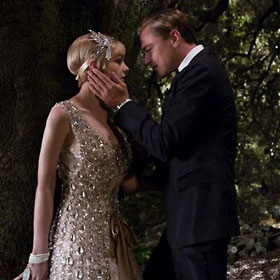‘The Great Gatsby’ Review: DiCaprio Delivers As Jay Gatsby In Baz Luhrmann’s Newest Rendition

4/5
The Great Gatsby, F. Scott Fitzgerald’s timeless classic on the Roaring Twenties, has been adapted four times for the small and silver screens. The latest version, created under director Baz Luhrmann’s (Moulin Rouge, 1996’s Romeo & Juliet) vision, is by far the most faithful interpretation of the novel.
Told in retrospective narration by writer Nick Carraway (Tobey Maguire), The Great Gatsby follows Nick’s relationship with his enigmatic neighbor, Jay Gatsby (Leonardo DiCaprio), who loves Nick’s cousin Daisy (Carey Mulligan), but cannot have her. She is married to Tom Buchanan (Joel Edgerton), an adulterous polo player with a clingy mistress Myrtle (Isla Fisher). Through Gatsby, Daisy, and Tom’s influence, Nick plunges into the frenetic, lavish world of New York’s rich and famous, where no one is alone, but everyone’s lonely. On the ultra-wealthy strip of Long Island, Gatsby has bought a mansion across the bay from Daisy’s and throws extravagant parties, made even more stunning by Luhrmann, in the hopes of attracting her attention. When she doesn’t attend, Nick helps to reunite the long-lost loves at his house. Though Gatsby and Daisy do reconnect, their fleeting happiness turns tragic for everyone involved.
The Great Gatsby is, in short, a pursuit of the American Dream, or a particular version of the American Dream. Gatsby, deluded by his desire for Daisy, invests the rest of his life to attaining her and believes that when he does, true happiness will be his. Unfortunately, his insurmountable wealth, esteem, and determination do little to woo Daisy away from Tom, and his efforts continue in vain. The world in which he lives is nothing more than gilded decay. The film’s progression is almost in total alignment with the novel’s sequence of events.
Gatsby boasts glitzy visuals and sweeping computer-generated urban landscapes inherent of a Luhrmann production. It succeeds in capturing the vivacious and often exhausting atmosphere of the novel and the decade in which it is set very well. Some viewers may find the CGI and 3D effects distracting, but I found they heighten drama and lend to the flamboyant, provocative space in which the characters live. Those who are hesitant about seeing the film in 3D (as I was) should be pleasantly surprised. What really stands out is Daisy’s green light, or Gatsby’s beacon. In 3D, it is a prevalent and overwhelming image, flashing at the viewer until it’s all he can see.
Another aspect from the novel that the film really emphasizes is Gatsby’s elite parties. The aesthetics of those scenes employ bright, bold, and intense colors. Flappers prance around a sparkling pool in equally sparkling dresses while confetti perpetually rains on the guests. The great golden organ in Gatsby’s entrance hall rises to a towering ceiling. Flashes of color interrupt quieter, tenser scenes: the red wallpaper of the hotel room, Gatsby’s pink suit and his yellow car. The merging of classical and modern music is especially successful too. Fireworks and Gershwin’s “Rhapsody in Blue” (can you not think of New York during this piece?) reach a crescendo when Nick finally meets Gatsby, while Jay-Z raps during a high-speed drive into the city.
In addition to cinematography, the actors played their parts sufficiently. Maguire does a nice job of narrating Nick’s regression from fresh-faced optimist to jaded bystander. I also enjoyed his little character twist involving a sanatorium. After facing so much disappointment, it is no wonder Nick ends up the way he does. His resentment towards Daisy and Tom’s lifestyle is profound. Edgerton is not as brutish or brash as former actors who played Tom Buchanan were, but he is not as refined as Gatsby either. Isla Fisher, Jason Clarke, and Elizabeth Debicki as Myrtle, George Wilson, and Jordan Baker, respectively, aren’t particularly memorable, but perhaps that is because their characters were not given enough screen time. Mulligan plays delicate and doe-eyed Daisy well, though her frivolity is overshadowed in some scenes where real emotion seems to lurk behind her eyes. The chemistry between her and DiCaprio isn’t particularly gratifying, nor should it be. Daisy has no idea what she wants.
I read in another review that DiCaprio is the most “vulnerable” Gatsby thus far. He definitely is. He is ambitious, devoted, and charismatic. Though Gatsby remains somewhat of an ambiguity by film’s end, DiCaprio conveys the character’s deepest anguish and desperation with a steely-eyed gaze. Even when he is faced with Daisy’s rejection, he struggles to remain optimistic. During Gatsby and Daisy’s reunion scene, I was on the edge of my seat enduring the never-ending buildup. I know the book and I know what would happen, but watching DiCaprio pace and fret was enough to make me anxious, too. His scenes with Mulligan are tender and sweet and worth rooting for, even when nothing good will come out of them. He’s so enraptured by her that he can’t see the bigger picture.
Apart from some lengthy conversations that crowd the second half of the film and climactic scenes which border on kitschy, The Great Gatsby is an elaborate and truly heartrending adaptation. The flashes of Daisy's green light in pitch black, coupled with Nick’s embittered narration, will haunt your mind’s eye long after the film has ended.
For more like this 'The Great Gatsby' movie review, check out Uinterview's movie review section here.
RELATED ARTICLES
Get the most-revealing celebrity conversations with the uInterview podcast!







Leave a comment